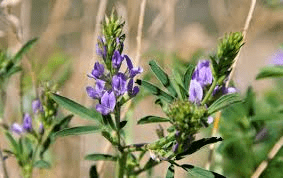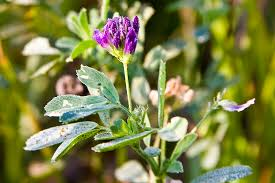Alfalfa inflorescence, known scientifically as Medicago sativa, features a unique inflorescence, or flowering structure, characterized by clusters of small, purple to blue flowers. These flowers are arranged in a spiral-shaped configuration along a central stem called a raceme.
Each flower consists of five petals and forms a pea-like shape. The inflorescence of alfalfa typically emerges from the upper portion of the plant, creating a visually striking display.
This flowering pattern not only adds aesthetic appeal but also serves as a crucial stage in the plant’s reproductive cycle, attracting pollinators such as bees and other insects.
The Economic Importance and Uses of Alfalfa Inflorescence

1. Forage Production: Alfalfa inflorescence contributes significantly to forage production, providing valuable nutrition for livestock. The flowers and seeds produced in the inflorescence are rich in protein, vitamins, and minerals, making them essential components of animal diets.
2. Seed Production: Alfalfa inflorescence plays a crucial role in seed production for alfalfa cultivation. The seeds harvested from mature inflorescences are used for planting new crops, ensuring continuous forage production and genetic diversity in alfalfa varieties.
3. Livestock Feed: The flowers and seeds of alfalfa inflorescence are used as feed for livestock, including cattle, sheep, goats, and horses. They provide essential nutrients for animal growth, reproduction, and overall health.
4. Genetic Improvement: Alfalfa inflorescence is important for genetic improvement programs aimed at developing new alfalfa cultivars with desirable traits such as improved yield, disease resistance, and nutritional quality. Breeding efforts focus on selecting superior inflorescences for seed production to enhance alfalfa performance.
5. Hay Production: Alfalfa inflorescence contributes to hay production, where the entire alfalfa plant, including inflorescences, is harvested and dried for use as animal feed. Alfalfa hay is a valuable source of nutrients for livestock, providing essential proteins, carbohydrates, and vitamins.
6. Soil Improvement: After alfalfa harvest, inflorescences left in the field decompose and contribute to soil improvement. As organic matter, they enrich the soil with nutrients, enhance soil structure, and promote microbial activity, leading to improved soil fertility and productivity.
7. Pollinator Habitat: Alfalfa inflorescence attracts pollinators such as bees, butterflies, and other beneficial insects with its abundant nectar and pollen resources. By providing a habitat for pollinators, alfalfa inflorescence supports pollination, fruit set, and seed production in agricultural landscapes.
8. Biodiversity: Alfalfa inflorescence contributes to biodiversity by providing habitat and food sources for various organisms, including insects, birds, and small mammals. Fields of flowering alfalfa plants, with their diverse flora and fauna, enhance ecological balance and wildlife conservation efforts.
9. Seed Industry: The seed industry relies on alfalfa inflorescence for the production of high-quality alfalfa seeds used by farmers worldwide. Seed companies invest in research and development to improve seed quality, yield, and germination rates to meet the demands of the agricultural market.
10. Cover Cropping: Alfalfa inflorescence is utilized in cover cropping systems to protect and improve soil health during fallow periods. Cover crops, including alfalfa, prevent soil erosion, suppress weeds, and fix nitrogen, contributing to sustainable agricultural practices and soil conservation.
11. Green Manure: Farmers incorporate alfalfa inflorescence into the soil as green manure to improve soil fertility and structure. As inflorescences decompose, they release nutrients such as nitrogen, phosphorus, and potassium, enriching the soil and promoting healthy plant growth.
12. Bioremediation: Alfalfa inflorescence has been used in bioremediation projects to remove contaminants from soil and water. The deep root systems of alfalfa plants, along with their inflorescences, absorb and accumulate pollutants, helping detoxify and rehabilitate contaminated sites.
13. Agroforestry Systems: Alfalfa inflorescence is integrated into agroforestry systems, where it contributes to soil improvement, erosion control, and biodiversity conservation. Agroforestry practices combine tree cultivation with agricultural crops, including alfalfa, to enhance ecosystem services and agricultural sustainability.
14. Landscape Beautification: Alfalfa inflorescence enhances the aesthetic appeal of landscapes with its colorful flowers and foliage. In urban and rural settings, fields of flowering alfalfa create visually stunning scenes and contribute to the beauty of natural and cultivated landscapes.
15. Pharmaceutical Industry: Alfalfa inflorescence contains bioactive compounds with potential pharmaceutical applications. Research into the medicinal properties of alfalfa extracts and compounds derived from inflorescences may lead to the development of new drugs and therapeutic agents.
16. Nutritional Supplements: Alfalfa inflorescence is used in the production of nutritional supplements and health products for human consumption. Extracts from alfalfa inflorescence are valued for their vitamins, minerals, and phytochemicals, which promote health and well-being.
17. Bioenergy Production: Alfalfa inflorescence can be utilized as feedstock for bioenergy production, contributing to renewable energy sources. Biomass from alfalfa inflorescence is converted into biofuels such as ethanol and biogas through fermentation and other biochemical processes.
Read Also: Cabbage Aphid: Description, Damages Caused, Control and Preventive Measures
The Products and By-products That Can Be Derived From Alfalfa Inflorescence

1. Alfalfa Seed: The seeds produced in alfalfa inflorescence are harvested and processed for use as planting material in alfalfa cultivation. These seeds are essential for establishing new alfalfa crops and maintaining genetic diversity in alfalfa varieties.
2. Forage: Alfalfa inflorescence contributes to forage production, providing valuable nutrition for livestock. The flowers and seeds are consumed by animals, offering protein, vitamins, and minerals essential for their growth and health.
3. Hay: Alfalfa inflorescence is harvested and dried to produce alfalfa hay, a nutritious feed for livestock. Haymaking preserves the nutritional quality of the inflorescence, allowing farmers to store and feed animals year-round.
4. Green Manure: After flowering, alfalfa inflorescence can be incorporated into the soil as green manure. As it decomposes, it releases nutrients into the soil, enriching it and improving soil fertility for subsequent crops.
5. Cover Crop: Alfalfa inflorescence is used as a cover crop to protect soil during fallow periods. Its dense growth shades the soil, preventing erosion and suppressing weed growth while adding organic matter.
6. Pollinator Habitat: The flowers of alfalfa inflorescence attract pollinators such as bees, which contribute to pollination and seed production. Maintaining alfalfa fields supports pollinator populations and enhances crop yields in neighboring crops.
7. Alfalfa Honey: Bees collect nectar from alfalfa inflorescence to produce alfalfa honey, known for its light color and delicate flavor. Alfalfa honey is popular among consumers and prized for its purity and quality.
8. Seed Industry: Alfalfa inflorescence is crucial for the seed industry, providing high-quality alfalfa seeds for planting. Seed companies select and process seeds from mature inflorescences to ensure genetic diversity and superior traits in alfalfa varieties.
9. Soil Improvement: Alfalfa inflorescence contributes to soil improvement by adding organic matter and nutrients to the soil. Its deep roots break up compacted soil, improve drainage, and enhance soil structure for better water and nutrient retention.
10. Bioremediation: Alfalfa inflorescence is used in bioremediation projects to remove contaminants from soil and water. Its deep root system and dense foliage absorb pollutants, helping to detoxify and rehabilitate polluted sites.
11. Nutritional Supplements: Extracts from alfalfa inflorescence are used in nutritional supplements and health products for humans. They contain vitamins, minerals, and phytochemicals that support overall health and well-being.
12. Herbal Medicine: Alfalfa inflorescence has been used in traditional herbal medicine for various ailments. It is believed to have diuretic, anti-inflammatory, and antioxidant properties, supporting health and healing.
13. Cosmetic Industry: Compounds derived from alfalfa inflorescence are used in skincare products for their moisturizing and anti-aging properties. Alfalfa extracts help hydrate and rejuvenate the skin, promoting a youthful appearance.
14. Pharmaceutical Research: Researchers study the bioactive compounds present in alfalfa inflorescence for potential pharmaceutical applications. These compounds show promise in treating various diseases and disorders, leading to the development of new drugs and therapies.
15. Landscape Design: Alfalfa inflorescence adds aesthetic value to landscapes with its colorful flowers and foliage. Landscapers use it in garden beds, borders, and meadows to create visually appealing and biodiverse environments.
16. Animal Foraging: Wildlife and grazing animals feed on alfalfa inflorescence, utilizing its nutritious flowers and seeds as food sources. By supporting wildlife populations, alfalfa fields contribute to ecosystem health and biodiversity conservation.
17. Bioenergy Production: Biomass from alfalfa inflorescence can be converted into biofuels such as ethanol and biogas through fermentation and other biochemical processes. This contributes to renewable energy production and reduces reliance on fossil fuels.
Read Also: How to Grow Fodder in 6 Days and Feed your Animals on the 7th Day
Frequently Asked Questions (FAQs) About Alfalfa Inflorescence

1. What is alfalfa inflorescence?
Alfalfa inflorescence refers to the flowering structure of the alfalfa plant, comprised of clusters of small, purple flowers arranged on a central stalk.
2. How is alfalfa inflorescence used in agriculture?
Alfalfa inflorescence is utilized for seed production, forage, hay, and as a cover crop in agricultural systems. It plays a crucial role in providing nutrition for livestock and improving soil health.
3. Do bees pollinate alfalfa inflorescence?
Yes, bees are primary pollinators of alfalfa inflorescence, visiting the flowers to collect nectar and pollen. Pollination by bees is essential for seed production in alfalfa crops.
4. Can alfalfa inflorescence be used in landscaping?
Alfalfa inflorescence can add beauty and biodiversity to landscaped areas, but its use may be limited due to its vigorous growth and potential for spreading.
5. What is the nutritional value of alfalfa inflorescence?
Alfalfa inflorescence contains protein, vitamins, and minerals beneficial for livestock and wildlife. It is a valuable source of nutrition in forage and hay production.
6. How long does alfalfa inflorescence bloom?
Alfalfa inflorescence typically blooms for several weeks during the growing season, attracting pollinators and facilitating seed production.
7. Is alfalfa inflorescence edible for humans?
While alfalfa inflorescence is not commonly consumed directly by humans, its flowers and seeds are nutritious and can be incorporated into herbal teas or dietary supplements.
8. What are the benefits of alfalfa inflorescence for soil health?
Alfalfa inflorescence contributes to soil health by adding organic matter, improving soil structure, and enhancing nutrient cycling through decomposition.
9. Are there different varieties of alfalfa inflorescence?
Alfalfa inflorescence may vary in flower color, size, and shape depending on the alfalfa variety or cultivar. Plant breeders develop new varieties with desirable traits for specific growing conditions.
10. How does alfalfa inflorescence contribute to sustainable agriculture?
Alfalfa inflorescence supports sustainable agriculture by providing nutritious forage, improving soil fertility, enhancing biodiversity, and reducing reliance on chemical inputs through biological nitrogen fixation.
Read Also: Practical Steps to Convert Printer Cartridges Wastes into New Printer Cartridges
